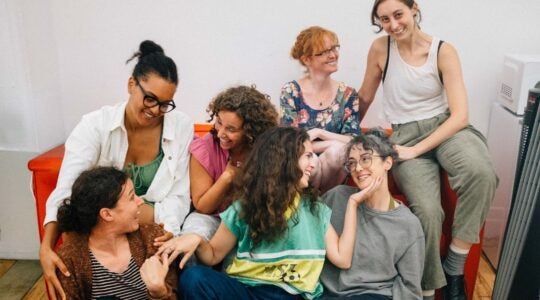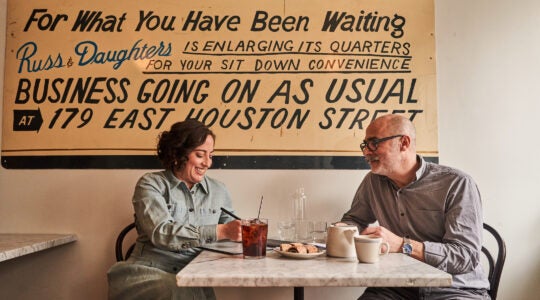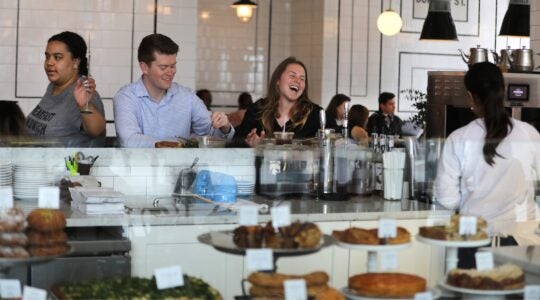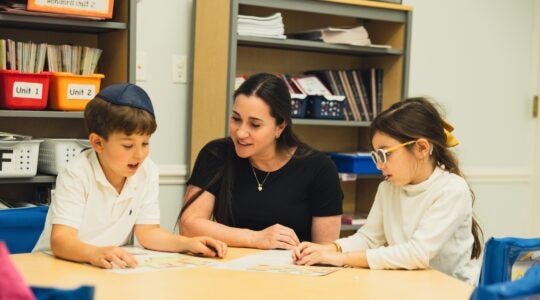The Pew Report on American Jewry has left the widespread impression that the liberal religious denominations are in trouble while Orthodox Judaism is thriving. Upon analysis, however, the Orthodox picture is more complicated. The charedi, or ultra wing of Orthodoxy, has surged in the past half-century while Modern Orthodoxy has had a near-death experience. Today there is a revival of the progressive wing of Orthodoxy but it is under fire from traditionalists. I believe the entire Jewish community has a major stake in the outcome and should get involved to assure a positive result.
Following is an analysis of American Orthodoxy in the last five decades and a case for why a strengthened progressive Orthodox movement can strengthen Jewish institutional and communal life.
The Split
Modern Orthodoxy, which sees itself as fully halachic while also embracing secular knowledge, suffered a precipitous decline in numbers in the past half-century. In 1960, as Pew and other researchers found, about one quarter of the older generation of American Jews identified as Orthodox. During that decade a number of liberation movements –women’s, black, gay — were launched. Multiculturalism flourished; anti-Semitism plummeted. As major beneficiaries of the expanded liberalism and acceptance, Jews shifted to the left – not just politically but also to less observance, toward the more liberal denominations, to less religion altogether, toward maximum integration in society, and consequently, more intermarriage.
Orthodoxy offered a mixed response. The more traditional elements recoiled, on the defensive. They moved to become stricter in observance, more insular and more authoritarian – in order to protect against the new “foreign” influences. They began to aggressively critique modern Orthodox “compromises” with American culture. They demanded stricter segregation of sexes and elevated (more separatist) kashrut standards. They also moved to take advantage of the new American openness to assert their distinctive dress, language and Jewish names, and to seek government aid for their institutions.
Many Modern Orthodox jumped into the new cultural currents – and not a few shifted to the left and even out of the community. Other Modern Orthodox were shocked by the new cultural revolutions and moved to the traditional side to insulate their children. The Modern Orthodox communal leadership moved to the right, adopting more traditionalist values and policies in their yeshivot and institutions. This included increased separation from (or delegitimation of) Conservative and Reform groups. They made new demands or expressed criticism of the “nonobservant Orthodox” – a significant percentage of members of Modern Orthodox synagogues who drove to synagogue on Shabbat, for example, while preferring the traditional service. Some of these synagogues, especially in the Midwest, had allowed mixed seating, or removal of mechitzot, or instituted both mixed and non-mixed seating sections of the sanctuary. These congregations were pressured to put in a mechitzah or leave the Union of Orthodox Jewish Congregations. These steps were taken to raise standards and to meet charedi criticisms. The result was a significant decline in Orthodox numbers as many of the nonobservant left or their children moved on.
The Orthodox percentage in American Jewry fell steadily. The low point was in the 1990 National Jewish Population Study in which only 7.7 percent of American Jews declared themselves to be Orthodox. Despite that fact, the Orthodox establishment was proclaiming its growing strength as well as its higher standards.
Modern Orthodox day school children were increasingly educated by teachers recruited from right-wing yeshivot. Yet parents continued to send these children to the best colleges. Some of those children found the cognitive dissonance between the university and the strict gender separation and ahistorical teachings of their rebbes to be unbearable. Many broke with Orthodoxy while others went on their post-high school gap year to Israel to “fortify” against college influences and were turned by their charedi trending rebbes into more ‘frum’ (traditionalist) and less modern Orthodox Jews.
Losing Its Way
Having lost its way and its self-confidence, the Modern Orthodox leadership increasingly yielded to ultra-Orthodox policies and leaders. Modern Orthodox rabbis left the denominationally mixed boards of rabbis in their communities. On the national level, the Synagogue Council of America –where Orthodox, Conservative and Reform were officially and jointly represented – was allowed to die. The sexes were separated in more day schools. Over the decades, conversion was tightened to require total observance from newcomers to the faith. The Rabbinical Council of America (RCA), the largest group of Orthodox rabbis, suffered membership losses as a number of Modern Orthodox synagogues lost nonobservant members and closed. Other shuls were lost to Conservative Judaism, while still others were challenged financially by the creation of separatists’ charedi-style “shtieblach” (informal congregations), whose low budgets – many did not have a rabbi or other paid staff – were appealing.
The RCA let its own siddur (prayerbook) go out of widespread use and replaced it with an Art Scroll Siddur, which was charedi in tone and rulings, and non-Zionist throughout. (This was covered with a fig leaf — a page with the Prayer for the State of Israel was inserted, but only in siddurim printed for RCA synagogues. It did not appear in the table of contents or index.)
Similarly, the Art Scroll Chumash, (funded by a leading Modern Orthodox philanthropist) replaced the generation-old Hertz Pentateuch with its more modern outlook. The new Art Scroll commentary stressed miracles and often offered rabbinic interpretation over the plain meaning of verses. These changes clashed with the secular culture that the Modern Orthodox youth would encounter in college, but the modern community had no influence on the commentary and lacked the scholarly energy to offer an alternative.
There are two classic cases of Modern Orthodoxy being taken over and transformed into charedi lite. One is the Young Israel movement, which represented the cutting edge of modern Orthodoxy up to the 1950s, even sponsoring dances to enable its young men and women to socialize American-style), swung to the right. Many of its rabbis are recruited from yeshivas opposed to secular studies and they mostly follow charedi policy. Its Council of Rabbis, for example, has decreed that no graduate of Yeshivat Chovevei Torah, founded by Rabbi Avi Weiss and espousing Open Orthodoxy, may be considered for a rabbinic position in the Young Israel movement.
The other major case involves Yeshiva University, the flagship institution of Modern Orthodoxy, whose Rosh Yeshiva was the late Rabbi Joseph Soloveitchik, the acknowledged leader of the Modern Orthodox movement and known widely as The Rav.
His primary successors over the last several decades at YU are yeshievish-charedi in their thinking and have broken with The Rav’s values in fundamental areas concerning modern culture. Unlike Rabbi Soloveitchik, who championed and embodied the synthesis of secular studies and Torah learning (and who sent his children to Harvard to get a quality secular education), his successors urged that Yeshiva College lighten its academic standards and expectations so students could maximize their Torah learning. They took on the mantle of Gedolim [Great Decisors] and taught that the Holy Spirit guides the rulings of Gedolim. Therefore they were, in a traditional sense, infallible and only a handful can qualify as Gedolim. Local rabbis were discouraged from making independent rulings. This is unlike Rabbi Soloveitchik who famously would reply to halachic questions posed to him by rabbis: What do you think? What is your ruling?
These rosh yeshivas have been unrelentingly antifeminist, with one recently questioning whether teaching women advanced Talmud – a YU program started by Rabbi Soloveitchik — was possibly a mistake as it led to the demand to ordain Orthodox women rabbis. (In this instance, YU’s administration said the statement did not reflect its values regarding women learning Torah.)
These rosh yeshivas were charedi in their treatment of alternate views – not as worthy of debate or as enriching Orthodox discourse but as ipso facto heresy to be silenced and expelled. Under their halachic guidance, the RCA refused to admit Orthodox rabbis ordained by the more liberal Yeshivat Chovevei Torah. And the RCA works closely with the Israeli Chief Rabbinate, which is increasingly haredi and exclusivist, most notably in its conversion policy. In return, the RCA’s conversion courts were given exclusive rights to certify or deny the legitimacy of converts, including those who converted through independent Modern Orthodox rabbis.
As a result of the charedization of YU's training and values, fewer of its musmachim (orainees) chose to go into synagogue pulpits out of discomfort with the inescapable compromises and departures from yeshivish standards. RIETS graduates have difficulty working on college campuses in the atmospher of openness and pluralism that dominates university life. When the Jim Joseph Foundation created an outreach corps of Hillel Senior Educators for the campuses, it found a disproportionate number of Yeshivat Chovevei graduates — but none from YU — to fill the need.
A climax came when Rabbi Avi Weiss and Yeshivat Maharat moved to ordain learned women who passed equivalent Talmud/halacha examinations as the men. Instead of rejecting the charedi position that nothing new [in this case, not hitherto done] is permitted in Orthodoxy, the RCA declared that ordaining women violated mesorah, or inherited tradition.
(It should be noted that the RCA did not cite credible halachic prohibitions. Further, it is worth noting as well that Modern Orthodoxy’s affirmation of secular culture and education, Torah education for women, and activist Zionism were declared violations of mesorah by charedim in the last century.).
In charedi style, the RCA threatened to expel Rabbi Weiss and exclude progressive Orthodox Jews from the Orthodox community, thus forcing him to compromise and not use the title of Rabbi (or Rabba) for women. He later withdrew from the RCA in protest.
The Growth Of Ultra-Orthodoxy
While Modern Orthodoxy weakened over the last 50 years, ultra-Orthodoxy found its way and was immensely strengthened in America. Assertive leadership by European rabbinical greats, such as Rabbi Aharon Kotler, who headed Beth Medrash Govoha, one of the largest yeshivas in the world, in Lakewood, NJ, and total dedication to institutional upbuilding yielded great results. As in Israel, where the government of Israel funded this wave, in America major underwriting from non-Orthodox Jews fueled this growth. Much of the funding came to support outreach to baalei teshuvah (returnees to tradition). This work was much heralded, though the actual numbers were quite low. With a combination of high birth rates and relatively low exit rates, the ultra-Orthodox population exploded.
One should add to this picture, the enormous organizational success of Lubavitch, which is said to be raising an estimated $1.5 billion a year in this country. Chabad differed from the ultra-Orthodox by its positive approach to Jews of every standard of observance and belief. Still, Lubavitch adds heft to the charedi community.
As for the overall charedi growth, one can only appreciate and admire the religious devotion, commitment of lives and hard work that enabled this success. It is a great pity that(Lubavitch aside) this achievement is being channeled to suppress modern Orthodoxy and into rejectionist policies toward non-Orthodox Jewish groupings, for this undercuts its ability to strengthen American Jewry.
The most recent Pew survey showed that Orthodoxy rebounded from 7.7 percent in 1990 to 10 percent of the national Jewish population. Most dramatic, though, was that unlike in 1960 when the dominant Orthodox defined themselves as modern, in 2014 two-thirds of the Orthodox described themselves as charedi and only one-third as modern. To put it another way: the modern Orthodox cohort had fallen from 14-15 percent of the national Jewish population to 3 percent — this, at the same time that a number of the main modern institutions had been co-opted to follow policies that favored charedi culture but weakened modern Orthodox viability.
The Rebirth Of Modern Orthodoxy
While the 2014 Pew study showed Modern Orthodox numbers down, the communal core is of high quality, with much strength. Its synagogue affiliation and Jewish identity rates are high and strongly positive, as are its birthrates and network of day schools and camps. Modern Orthodoxy also became the group with the highest level of academic and advanced degree education. Historically, higher income and education statistics skewed toward the more liberal denominations and integrated Jews.
Modern Orthodoxy emerged as the denomination with the highest average income – apparently because in many families, both spouses were high-income professionals. Current Modern Orthodoxy is far more sophisticated in its interaction with American culture than its predecessor generation, which enables it to deal with intellectual/scholarly challenges as well as to speak more effectively to the rest of American Jewry. All of this points to future growth capabilities.
The institutional expression of the new social base for Modern Orthodoxy has grown rapidly. A remarkable array of options for women’s advanced Torah study has helped raise the most Jewishly learned, halachically knowledgeable and active cohort of women in Jewish history. It began with Drisha Institute in 1979. JOFA (the Jewish Orthodox Feminist Alliance) was founded in 1998, and despite fierce opposition has won many improvements in women's place in Orthodoxy, including partnership minyanim that expand women’s roles. Modern Orthodox publications have made a comeback. Koren Publishers and the Orthodox Union (OU) copublished a new modern Zionist Siddur with translation and commentary by Sir Rabbi Jonathan Sacks. Koren is publishing the Steinsaltz Talmud with new English translation and has created a rich library of Modern Orthodox thinkers (including Rabbi Shlomo Riskin) in its Maggid series.
Rabbi Avi Weiss created Yeshivat Chovevei Torah to teach a more spiritual, ethical and Clal Yisrael-oriented Orthodoxy to rabbis. The school now has more than 100 practicing rabbis in the field, and is growing. The International Rabbinic Fellowship, created by Rabbis Marc Angel and Rabbi Weiss to serve as a more liberal Modern Orthodox rabbinic organization, has more than 200 members. They are widely distributed, with particular strength in communal organizations and Hillel/university settings. In 2009, Rabbi Weiss launched Yeshivat Maharat to train Orthodox women clergy. The school has 11 graduates (all placed professionally) and 22 students currently registered, and growing.
Alarmed by this growth and the perceived threat that new women’s roles, as well as deeper connections to the rest of the community, could shift the balance of power away from ultra-Orthodoxy, Agudath Israel of America and its Council of Sages made a preemptive strike. This past year it proclaimed that Open Orthodoxy, the term Rabbi Weiss prefers for Modern Orthodoxy, is a breach of true Orthodoxy and is to be excluded from the community. Sadly, instead of protesting this attempt by charedim to assume total hegemony over Modern Orthodoxy, the RCA (and YU) remain silent – with some internal elements pushing that they join this attempt at excommunication.
The next test of the staying power of the revival is PORAT (People for Orthodox Renaissance and Torah). This is a new organization, catalyzed by Rabbi Weiss, and its launch is scheduled for May 15 in a public conference at Congregation Kehilath Jeshurun in Manhattan. PORAT seeks to become a lay organization to advance the agenda of an inclusive, Jewish Peoplehood- oriented Modern Orthodoxy. Its first goal is to make clear that despite the co-opting of Modern Orthodox institutions by those on the right, a significant percentage of the community wants more equality and dignity for women, more inclusive treatment of gay and other minorities, and embraces the whole Jewish people.
PORAT is calling for policies that respect and cooperate with the other groupings in Jewry and not to put them down or seek to advance Orthodoxy by exploiting or excluding them. PORAT’s founders are committed to create a culture of respectful conversation and plural experimentation so that Orthodoxy can deal positively with the social, economic and cultural advances of our time – without seeking to shut them out via reactionary exclusion. The charedized leadership establishment in Modern Orthodoxy has already raised objections. Progressive laypeople will have to show up and stand up for their values and engage the Orthodox established organizations and move them toward Clal Yisrael and positive modernity.
What is at stake for the 90 percent – the rest of American Jewry – in this matter? Modern Orthodox professionals have played a key role in the revitalization of American Jewry in the past half-century. This revival is a primary bulwark against looming assimilation. Unless Modern Orthodoxy is reborn, the cohort of leading, community-embracing professionals of Jewish life, including communal affairs, education and spirituality will not be there in the next generation.
In addition, the ultra Orthodox renaissance of recent decades is of little utility for the rest of American Jewry in its struggle to achieve integration without assimilation. The charedi solution — adopted by the co-opted centrist Orthodox camp – is to work out some geographic, cultural or ethical shelter that permits its own culture to flourish. But it cannot much help the 90 percent of American Jews who are committed to full integration and maintaining a vibrant Jewish identity inside the general culture. The continuing second-class status for women, the delegitimization of alternative movements, the exclusion of minorities, the use of monopoly and political force to impose observance on others – all weaken the pull of Jewish identity and culture in the eyes of more integrated Jews. These values turn them off religiously, which weakens their ability to resist assimilation.
A new infusion of an invigorated Modern Orthodoxy that meets the best intellectual, moral and spiritual standards of postmodern culture is a critical ingredient for the strengthening of the center of affiliated Jewry. Much of Modern Orthodoxy’s practices and associations can be adopted or adapted to shore up non-Orthodox Jews’ lives and community. This strengthening is a sine qua non for survival and renewal of American Jewry.
The time is now to support and invest in a rebirth of Modern Orthodoxy. Such an investment will yield a major return in depth and vitality for the rest of American Jewry and the state of Israel.
Rabbi Yitz Greenberg is a scholar and author. His newest book, “Sage Advice” (Maggid Books), is a translation and interpretation of Pirkei Avot, the Ethics of the Sages.
The New York Jewish Week brings you the stories behind the headlines, keeping you connected to Jewish life in New York. Help sustain the reporting you trust by donating today.




